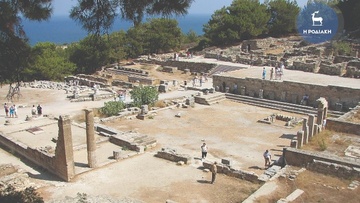Τhe calendar of Rhodes
ΑΝΑΓΝΩΣΤΗΚΕ 623 ΦΟΡΕΣ
Like all the ancient Greek calendars, the Rhodian calendar was lunar and it followed the phases of the Moon.
The first day of each month was identified with the New Moon (nouminia), while the aggregated differences to the solar year were governed by the periodic introduction of an intercalary month which in Rhodes was called Panamus B.
The month always began after sunset and with the appearance of the New Moon. It wasn’t divided into weeks but into three “tens”. The first “ten” was called "standing”, “consecutive” or “incipient”, the second “ten” was called “intermediate” and the third “diminishing” or “departing”.
So, the first of each month, the “nouminia” was followed by the "second standing" etc. until the tenth. The first of the “intermediate ten” followed until the twentieth day arrived which was called “eikada”. The month was completed with the third “ten”, which was counted backwards. The “tenth diminishing”, the “ninth diminishing” and so on until the last day of the month arrived which was called “eni”.
Of course all the names of the months of the Rhodian calendar had religious and mythical origins, recalling the corresponding celebrations in honor of one or another deity and especially the Helios-Apollo Sun god.
Thesmophorios (October-November)
Thesmophoria was a purely female festival. Indirect information from other cities tell us that they took place during the autumnal equinox. During Thesmophoria, women gathered for a few nights in the sanctuaries of Demeter and Kore (Persephone), having with them only the children they breastfed. The ceremonies were to honor the fertility of the Earth as well as the fertility of women.
The participation and presence of men was prohibited. During Thesmophoria, women honored the goddess Demeter and Mother Earth. It is quite probable that the Rhodian village Damatria got its name from goddess Demeter if we take into account the pronunciation of the Doric dialect.
Diosthyos (November-December)
The sacrifices to Zeus in the second month of autumn, is undoubtedly related to the need for rainfall. The father of gods and king of Olympus, was worshiped as the god of the fertile rain and lightning, with hundreds of annominations. It is probable that the month Diosthyos included pandemic celebrations in the honor of Zeus with congruent sacrifices.
One of the many proposals concerning the etymology of the name of the king of the gods connects the name with the verb “devo” which means "to rain, to irrigate." So the Deus-Zeus is the supreme rainmaking god.
Theudasios (December-January)
The name of the third Rhodian month could owe its etymology to “divine symposium”, because “theus” means god and “da(i)sios” means a portion of meat and consequently a “banquet”. Possibly, during that month there were many festivities and banquets since there wasn’t much agricultural work to be done.
Pedageitnyos (January – February)
If the name of the fourth Rhodian month is associated with the verb “petannymi”, meaning “to stretch, to open” and the noun “geitnia” which means “neighboring”, then perhaps there is an indication that during this month a lot of weddings took place with many neighbors being invited.
Badromios (February-March)
Undoubtedly this is the Doric name of the Boedromion month in the Attic calendar, with the difference that the Rhodian month is in winter while the Attic one was in the summer. It is probably derived from the words “noise” and “road” and refers to the screaming of warriors during an attack. It is certainly linked to a mythical event which unfortunately remains unclear due to the lack of sources.
Sminthios (March-April)
“Sminthos” means “mouse” in ancient Greek and “Sminthios” was one of the many names of Apollo, as the eliminator of mice. The ancients attributed the salvation of cities or regions from the destructive actions of rodents to god Apollo. Undoubtedly, the month was dedicated to Apollo.
Artamitios (April-May)
The verb “artameo” means “to shred, to cut into pieces” and the noun “artamos” means “slaughterer, shredder”. It is possible that the month’s name is derived from these words which etymologically refer to Artemis, goddess of the moon and hunting. Similarly, the name of Mount Artamitis southwest of Rhodes shares the same etymology. It is quite obvious that this month was dedicated to Artemis.
Agrianios (May-June)
Possibly the name of the month is associated with the “Agriad Nymphs”, the female deities that protected the cultivated fields. During the harvest season, people were obliged to honor those deities. It was imperative and necessary. The month Agrianios is also mentioned in the Antikethyra mechanism.
Hyacynthios (June-July)
Modern day botanists identify the hyacinth with “hyacinth orientalis” and with a number of other plants. But the classical lexicographers insist that the ancient hyacinth plant is the red iris, a type of wild lily with petals onto which the ancient Greeks saw the Y A letters and that is how the plant got its name.
We are aware of the Doric mythological version, where Hyacinth was a handsome young man from Amycles-Laconia who accompanied Apollo in discus throwing. One day Apollo and Hyacinth took turns throwing the discus and Hyacinth ran to catch it to impress Apollo.
Unfortunately, he, was struck by the discus as it fell to the ground, and died. When Hyacinth died, Apollo did not allow Hades to claim the youth; rather, he made a flower, the hyacinth, from his spilled blood.
According to Ovid's account, the tears of Apollo stained the newly formed flower's petals with the sign of his grief. Hyacinth was the tutelary deity of one of the principal Spartan festivals, the “Hyacinthia”, held every summer. The festival lasted three days, one day of mourning for the death of Hyacinth, and the last two celebrating his rebirth as Apollo Hyakinthios. It seems that the Rhodians celebrated the “Hyacinthia” like the Spartans.
Panamos (July-August)
The name of this month can be found in many other ancient Greek calendars such as the calendars of Argos, Epidaurus, Megara, Corinth and Thespiae. The name is possibly derived from the word “panemar” which means “all-day” and refers to a full-day religious holiday that took place in the summer. The month of Panamos is also found in the Antikethyra mechanism.
Carneios (August-September)
Carnos was the name of an ancient shepherd, sheep-headed god with a phallic erection. In the process of time, Carneus was identified with Apollo in almost all Doric societies. Five unmarried youths, the Carneatae, were chosen by lot from each tribe for four years, to superintend the proceedings, the officiating priest being called “agitis” (leader).
A man decked with garlands (possibly the priest himself) started running, pursued by a band of young men called “stafylodromoi”(“running with bunches of grapes in their hands”); if he was caught, it was a guarantee of good fortune to the city; if not, the reverse.
Dalios (September-October)
Dalios is the Doric version of the word Delios and it surely refers to the month that was dedicated to the god of light, Apollo, born at Delos while in Rhodes, god Apollo was identified with the sun god Helios.









 Ακολουθήστε τη Ροδιακή στο Google News
Ακολουθήστε τη Ροδιακή στο Google News









